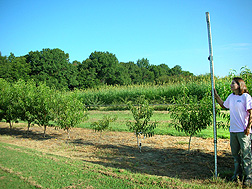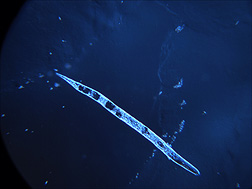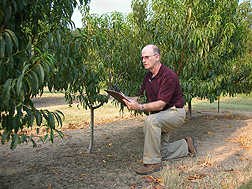Tall Fescue Ground Cover StiflesNematodes in Peach Orchards
Peach growers in the southeastern United States are vexed in dealing with root-knot nematodes that can severely stunt peach tree growth. Traditionally, growers have fumigated peach orchard soils prior to planting and then used a nematode-resistant rootstock. But in recent years, growers have faced tough times that have made it difficult to afford preplant fumigants, such as Telone II or Vapam, and many growers also have difficulty with fumigating at the recommended time of year because of conflicts with managing other crops.
At a peach growers’ meeting a few years ago, the question was raised as to whether a preplant ground-cover crop could be used to control nematodes instead of fumigation.
Agricultural Research Service plant pathologists Andy Nyczepir at the Southeastern Fruit and Tree Nut Research Laboratory in Byron, Georgia, and Susan Meyer at the Nematology Laboratory in Beltsville, Maryland, set out to find the answer. Their results were published in the Journal of Nematology in 2010.
“In Georgia, rotation with coastal Bermuda grass, which can also be harvested for hay, is recommended for control of Meloidogyne, or root-knot nematode,” says Nyczepir. “Another potential ground-cover rotation crop for nematode management is tall fescue grass.” Tall fescue is the most widely grown perennial, cool-season, turf and forage grass species, and it is well adapted in the area between the temperate northeastern and subtropical southeastern United States.
In their greenhouse studies, Nyczepir and Meyer investigated four tall fescue varieties, three of which were infected with fungal endophytes that live within the plant—typically between its cells—but do not cause disease in it.
|
|
Some Nematodes Neutralized with Tall Fescue
The four tall fescue varieties tested were a wild-type Jesup (with an ergot-producing endophyte), endophyte-free Jesup, Jesup MaxQ (with a non-ergot producing endophyte), and Georgia 5 (with an ergot-producing endophyte). Ergot is a toxic fungus that grows on rye and other grasses.
“It has been reported by other researchers that the presence of the fungal endophyte in tall fescue confers resistance to some plant-parasitic nematodes,” says Nyczepir. “But the presence of an endophyte is not always beneficial; it has been associated with causing fescue toxicosis in grazing animals. Fescue toxicosis is marked by elevated body temperature, poor weight gain, and reduced prolactin concentrations in the animals.”
One way to avoid fescue toxicosis is to grow tall fescue with nontoxic strains of the fungal endophyte.
|
|
“One such endophyte-friendly commercial tall fescue variety is MaxQ,” says Nyczepir. “But MaxQ’s susceptibility to nematodes was unknown, so we decided to evaluate the host susceptibility of MaxQ and three other tall fescue varieties to several root-knot nematode species: M. arenaria, M. hapla, M. incognita, and M. javanica.”
“Our studies demonstrated that two of the nematodes—M. incognita and M. hapla—can’t reproduce on MaxQ. Meloidogyne javanica has a low level of reproduction on MaxQ, but M. arenaria can reproduce on it,” says Meyer. “This shows that MaxQ may well have potential as a preplant control strategy for M. incognita and M. hapla in southeastern and northeastern U.S. areas. Using this tall fescue as a preplant cover crop treatment may allow growers to reduce the use of chemical nematicides.”
“We are following up these greenhouse studies with field testing of MaxQ as an alternative to preplant chemical control of M. incognita,” says Nyczepir.
The team’s field trials using MaxQ as a preplant cover crop have so far found that peach trees planted after the cover crop are larger than those planted in soil that is not fumigated.
|
|
“Preliminary data indicates that trees planted after a 1-year or 2-year MaxQ grass cover crop and trees planted in fumigated soil are significantly larger than trees in unfumigated soil,” says Nyczepir. The peach trees that were planted after a 2-year period of growing MaxQ as a cover crop were larger than the trees planted after a 1-year period of MaxQ, indicating that the longer time had an even more beneficial effect on plant growth.
The boost in tree growth from waiting the extra year may be just what growers need. After all, as the researchers say, once a tree has been established for 3 years, damage caused by root-knot nematode is minimal, so anything that helps peach trees be healthier and stronger their first year or more is probably a good thing.—By Sharon Durham, Agricultural Research Service Information Staff.
This research is part of Plant Diseases, an ARS national program (#303) described at www.nps.ars.usda.gov.
Andrew Nyczepir is with the USDA-ARS Southeastern Fruit and Tree Nut Research Laboratory, 21 Dunbar Rd., Byron, GA 31008; (478) 956-6438.
Susan Meyer is with the USDA-ARS Nematology Laboratory, 10300 Baltimore Ave., Bldg. 011A, Beltsville, MD 20705-2350; (301) 504-5091.
"Tall Fescue Ground Cover StiflesNematodes in Peach Orchards" was published in the November/December 2011 issue of Agricultural Research magazine.










